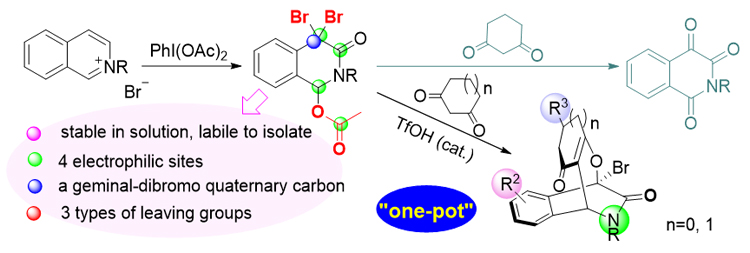| [1] |
(a) Li, K.; Ou, J.-J.; Gao, S. Angew. Chem., Int. Ed. 2016, 55, 14778.
|
|
(b) Wang, B.-X.; Xu, Z.-X.; Wu, J. Chin. J. Org. Chem. 2006, 26, 1587. (in Chinese)
|
|
王炳祥, 徐助雄, 吴婧, 有机化学 2006, 26, 1587.)
|
|
(c) Shi, L.; Ji, Y.; Huang, W.-X.; Zhou, Y.-G. Acta Chim. Sinica 2014, 72, 820. (in Chinese)
|
|
( 时磊, 姬悦, 黄文学, 周永贵, 化学学报 2014, 72, 820.)
doi: 10.6023/A14050391
|
| [2] |
Capacci, A. G.; Dechantsreiter, M.; Enyedy, I.; Jones, J. H.; Lin, E. Y.-S.; Lucas, B. S.; Ma, B. WO 2018140876, 2018
|
|
[Chem. Abstr. 2018, 169, 242866 ]
|
| [3] |
Tanifuji, R.; Minami, A.; Oguri, H.; Oikawa, H. Nat. Prod. Rep. 2020, 37, 1098.
doi: 10.1039/c9np00073a
pmid: 32141467
|
| [4] |
Krishnan, S.; Bagdanoff, J. T.; Ebner, D. C.; Ramtohul, Y. K.; Tambar, U. K.; Stoltz, B. M. J. Am. Chem. Soc. 2008, 130, 13745.
doi: 10.1021/ja804738b
pmid: 18798630
|
| [5] |
Le, V. H.; Inai, M.; Williams, R. M.; Kan, T. Nat. Prod. Rep. 2015, 32, 328.
doi: 10.1039/c4np00051j
pmid: 25273374
|
| [6] |
(a) Ding, B.-D.; Jiang, Y.-C.; Zhang, Y.; Ye, R.; Sun, J.; Yan, C.-G. Chin. J. Org. Chem. 2020, 40, 1003. (in Chinese)
|
|
( 丁邦东, 姜业朝, 张瑜, 叶蓉, 孙晶, 颜朝国, 有机化学 2020, 40, 1003.)
doi: 10.6023/cjoc201910016
|
|
(b) Shen, G.-L.; Sun, J.; Yan, C.-G. Chin. J. Chem. 2016, 34, 412.
|
|
(c) Niu, F.; Cui, Z.; Chang, H.-T.; Jiang, Y.; Chen, F.-K.; Tu, P.-F. Chin. J. Chem. 2006, 24, 1788.
|
|
(d) Wang, L.-L.; Zhang, Z.-Y.; Han, H.-B.; Liu, X.-L.; Bu, Z.-W.; Wang, Q.-L. Chin. J. Org. Chem. 2021, 41, 12. (in Chinese)
|
|
( 王乐乐, 张子莹, 韩华彬, 刘雄利, 卜站伟, 王琪琳, 有机化学 2021, 41, 12.)
doi: 10.6023/cjoc202007045
|
|
(e) Das, S. Org. Biomol. Chem. 2022, 20, 1838.
|
|
(f) Zhang, Z.-Y.; Han, H.-B.; Wang, L.-L.; Bu, Z.-W.; Xie, Y.; Wang, Q.-L. Org. Biomol. Chem. 2021, 19, 3960.
|
|
(g) Sharma, U. K.; Ranjan, P.; Van der Eycken, E. V.; You, S.-L. Chem. Soc. Rev. 2020, 49, 8721.
|
|
(h) Xu, J.-H.; Zheng, S.-C.; Zhang, J.-W.; Liu, X.-Y.; Tan, B. Angew. Chem., Int. Ed. 2016, 55, 11834.
|
|
(i) Bai, X.-G.; Miao, H.-J.; Zhao, Y.; Wang, Q.-L.; Bu, Z.-W. Org. Lett. 2020, 22, 5068.
|
|
(j) Miao, H.-J.; Wang, L.-L.; Han, H.-B.; Zhao, Y.-D.; Wang, Q.-L.; Bu, Z.-W. Chem. Sci. 2020, 11, 1418.
|
|
(k) Miao, H.-J.; Bai, X.-G.; Wang, L.-L.; Yu, J.-H.; Wang, Q.-L.; Bu, Z.-W. Org. Chem. Front. 2021, 8, 204.
|
| [7] |
Lin, X.-L.; Yu, Y.; Zhang, L.; Leng, L.-J.; Xiao, D.-R.; Cai, T.; Luo, Q.-L. Org. Chem. Front. 2022, 9, 4676.
|
| [8] |
For details, see the Supporting Information.
|
| [9] |
Increasing the reaction temperature did not improve the yield of isoquinoline-1,3,4-triones (also see the section of 2.2.1). Therefore, O-SN1 could be ruled out.
|
| [10] |
Bai, L.-G.; Zhou, Y.; Zhuang, X.; Zhang, L.; Xue, J.; Lin, X.-L.; Cai, T.; Luo, Q.-L. Green Chem. 2020, 22, 197.
|
| [11] |
Wang, S.-K.; Chen, M.-T.; Zhao, D.-Y.; You, X.; Luo, Q.-L. Adv. Synth. Catal. 2016, 358, 4093.
|
 )
)
